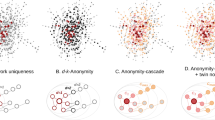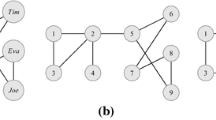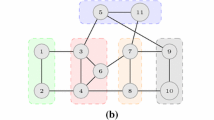Abstract
The advent of social network sites in the last years seems to be a trend that will likely continue. What naive technology users may not realize is that the information they provide online is stored and may be used for various purposes. Researchers have pointed out for some time the privacy implications of massive data gathering, and effort has been made to protect the data from unauthorized disclosure. However, the data privacy research has mostly targeted traditional data models such as microdata. Recently, social network data has begun to be analyzed from a specific privacy perspective, one that considers, besides the attribute values that characterize the individual entities in the networks, their relationships with other entities. Our main contributions in this paper are a greedy algorithm for anonymizing a social network and a measure that quantifies the information loss in the anonymization process due to edge generalization.
Preview
Unable to display preview. Download preview PDF.
Similar content being viewed by others
References
Bader, D.A., Madduri, K.: GTGraph: A Synthetic Graph Generator Suite (2006), http://www.cc.gatech.edu/~kamesh/GTgraph/
Backstrom, L., Dwork, C., Kleinberg, J.: Wherefore Art Thou R3579X? Anonymized Social Networks, Hidden Patterns, and Structural Steganography. In: International World Wide Web Conference (WWW), pp. 181–190 (2007)
Bamba, B., Liu, L., Pesti, P., Wang, T.: Supporting Anonymous Location Queries in Mobile Environments with PrivacyGrid. In: ACM World Wide Web Conference (2008)
Byun, J.W., Kamra, A., Bertino, E., Li, N.: Efficient k-Anonymization using Clustering Techniques. In: Kotagiri, R., Radha Krishna, P., Mohania, M., Nantajeewarawat, E. (eds.) DASFAA 2007. LNCS, vol. 4443, pp. 188–200. Springer, Heidelberg (2007)
Chakrabarti, D., Zhan, Y., Faloutsos, C.: R-MAT: A Recursive Model for Graph Mining. In: SIAM International Conference on Data Mining (2004)
Ciriani, V., Vimercati, S.C., Foresti, S., Samarati, P.: K-Anonymity. In: Secure Data Management In Decentralized Systems, pp. 323–353 (2007)
Ghinita, G., Karras, P., Kalinis, P., Mamoulis, N.: Fast Data Anonymization with Low Information Loss. In: Very Large Data Base Conference (VLDB), pp. 758–769 (2007)
Han, J., Kamber, M.: Data Mining. In: Concepts and Techniques, 2nd edn. Morgan Kaufmann, San Francisco (2006)
Hay, M., Miklau, G., Jensen, D., Weiss, P., Srivastava, S.: Anonymizing Social Networks. Technical Report No. 07-19, University of Massachusetts Amherst (2007)
Hay, M., Miklau, G., Jensen, D., Towsley, D., Weis, P.: Resisting Structural Re-identification in Anonymized Social Networks. In: Very Large Data Base Conference (VLDB), pp. 102–114 (2008)
HIPAA. Health Insurance Portability and Accountability Act (2002), http://www.hhs.gov/ocr/hipaa
Lambert, D.: Measures of Disclosure Risk and Harm. Journal of Official Statistics 9, 313–331 (1993)
LeFevre, K., DeWitt, D., Ramakrishnan, R.: Mondrian Multidimensional K-Anonymity. In: IEEE International Conference of Data Engineering (ICDE), vol. 25 (2006)
Li, N., Li, T., Venkatasubramanian, S.: T-Closeness: Privacy Beyond k-Anonymity and l-Diversity. In: IEEE International Conference on Data Engineering (ICDE), pp. 106–115 (2007)
Liu, K., Terzi, E.: Towards Identity Anonymization on Graphs. In: ACM SIGMOD International Conference on Management of Data, pp. 93–106 (2008)
Lunacek, M., Whitley, D., Ray, I.: A Crossover Operator for the k-Anonymity Problem. In: Genetic and Evolutionary Computation Conference (GECCO), pp. 1713–1720 (2006)
Machanavajjhala, A., Gehrke, J., Kifer, D.: L-Diversity: Privacy beyond K-Anonymity. In: IEEE International Conference on Data Engineering (ICDE), vol. 24 (2006)
Malin, B.: An Evaluation of the Current State of Genomic Data Privacy Protection Technology and a Roadmap for the Future. Journal of the American Medical Informatics Association 12(1), 28–34 (2005)
Meyerson, A., Williams, R.: On the complexity of optimal k-anonymity. In: ACM PODS Symposium on the Principles of Database Systems, pp. 223–228 (2004)
Newman, D.J., Hettich, S., Blake, C.L., Merz, C.J.: UCI Repository of Machine Learning Databases (1998), http://www.ics.uci.edu/~mlearn/MLRepository.html
Potterat, J.J., Philips-Plummer, L., Muth, S.Q., Rothenberg, R.B., Woodhouse, D.E., Maldonado-Long, T.S., Zimmerman, H.P., Muth, J.B.: Risk Network Structure in the Early Epidemic Phase of HIV Transmission in Colorado Springs. Sexually Transmitted Infections 78, 159–163 (2002)
Samarati, P.: Protecting Respondents Identities in Microdata Release. IEEE Transactions on Knowledge and Data Engineering 13(6), 1010–1027 (2001)
Shetty, J., Adibi, J.: The Enron Email Dataset Database Schema and Brief Statistical Report (2004), http://www.isi.edu/~adibi/Enron/Enron_Dataset_Report.pdf
Sweeney, L.: K-Anonymity: A Model for Protecting Privacy. International Journal on Uncertainty, Fuzziness, and Knowledge-based Systems 10(5), 557–570 (2002)
Sweeney, L.: Achieving k-Anonymity Privacy Protection Using Generalization and Suppression. International Journal on Uncertainty, Fuzziness, and Knowledge-based Systems 10(5), 571–588 (2002)
Truta, T.M., Bindu, V.: Privacy Protection: P-Sensitive K-Anonymity Property. In: PDM Workshop, with IEEE International Conference on Data Engineering (ICDE), vol. 94 (2006)
Tse, H.: An Ethnography of Social Networks in Cyberspace: The Facebook Phenomenon. The Hong Kong Anthropologist 2, 53–77 (2008)
Ward, H.: Prevention Strategies for Sexually Transmitted Infections: Importance of Sexual Network Structure and Epidemic Phase. Sexually Transmitted Infections 83, 43–49 (2007)
Wang, T., Liu, L.: Butterfly: Protecting Output Privacy in Stream Mining. In: IEEE International Conference on Data Engineering (ICDE), pp. 1170–1179 (2008)
Wong, R.C.W., Li, J., Fu, A.W.C., Wang, K.: (α, k)-Anonymity: An Enhanced k-Anonymity Model for Privacy-Preserving Data Publishing. In: SIGKDD, pp. 754–759 (2006)
Zheleva, E., Getoor, L.: Preserving the Privacy of Sensitive Relationships in Graph Data. In: ACM SIGKDD Workshop on Privacy, Security, and Trust in KDD (PinKDD), pp. 153–171 (2007)
Zhou, B., Pei, J.: Preserving Privacy in Social Networks against Neighborhood Attacks. In: IEEE International Conference on Data Engineering (ICDE), pp. 506–515 (2008)
Author information
Authors and Affiliations
Editor information
Editors and Affiliations
Rights and permissions
Copyright information
© 2009 Springer-Verlag Berlin Heidelberg
About this paper
Cite this paper
Campan, A., Truta, T.M. (2009). Data and Structural k-Anonymity in Social Networks. In: Bonchi, F., Ferrari, E., Jiang, W., Malin, B. (eds) Privacy, Security, and Trust in KDD. PInKDD 2008. Lecture Notes in Computer Science, vol 5456. Springer, Berlin, Heidelberg. https://doi.org/10.1007/978-3-642-01718-6_4
Download citation
DOI: https://doi.org/10.1007/978-3-642-01718-6_4
Publisher Name: Springer, Berlin, Heidelberg
Print ISBN: 978-3-642-01717-9
Online ISBN: 978-3-642-01718-6
eBook Packages: Computer ScienceComputer Science (R0)




